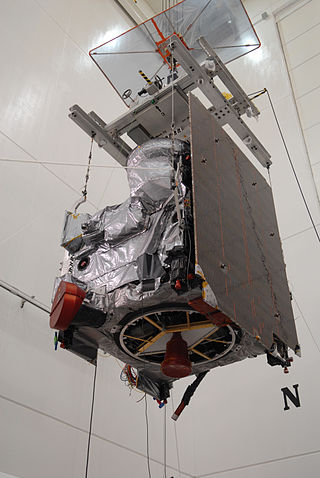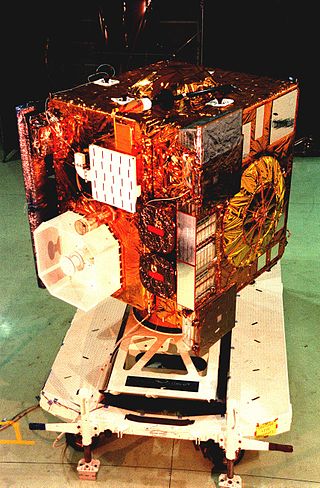
The Geostationary Operational Environmental Satellite (GOES), operated by the United States' National Oceanic and Atmospheric Administration (NOAA)'s National Environmental Satellite, Data, and Information Service division, supports weather forecasting, severe storm tracking, and meteorology research. Spacecraft and ground-based elements of the system work together to provide a continuous stream of environmental data. The National Weather Service (NWS) and the Meteorological Service of Canada use the GOES system for their North American weather monitoring and forecasting operations, and scientific researchers use the data to better understand land, atmosphere, ocean, and climate dynamics.
JCSAT-11, was a geostationary communications satellite ordered by JSAT Corporation which was designed and manufactured by Lockheed Martin on the A2100 platform. The satellite was designated to be used as an on-orbit, but was lost on launch failure.

GOES-14, known as GOES-O prior to reaching its operational orbit, is an American weather satellite, which is part of the US National Oceanic and Atmospheric Administration (NOAA)'s Geostationary Operational Environmental Satellite (GOES) system. The spacecraft was built by Boeing and is based on the BSS-601 bus. It is the second of three GOES satellites to use the BSS-601 bus, after GOES-13, which was launched in May 2006.

Sirius FM-5, also known as Radiosat 5, is an American communications satellite which is operated by Sirius XM Radio. It was constructed by Space Systems Loral, based on the LS-1300 bus, and carries a single transponder designed to transmit in the NATO E, F and I bands. It is currently being used to provide satellite radio broadcasting to North America.
JCSAT-RA, previously known as JCSAT-12, is a Japanese geostationary communications satellite, which is operated by SKY Perfect JSAT Group.

EWS-G1 is a weather satellite of the U.S. Space Force, formerly GOES-13 and part of the National Oceanic and Atmospheric Administration's Geostationary Operational Environmental Satellite system. On 14 April 2010, GOES-13 became the operational weather satellite for GOES-East. It was replaced by GOES-16 on 18 December 2017 and on 8 January 2018 its instruments were shut off and it began its three-week drift to an on-orbit storage location at 60.0° West longitude, arriving on 31 January 2018. It remained there as a backup satellite in case one of the operational GOES satellites had a problem until early July 2019, when it started to drift westward and was being transferred to the U.S. Air Force, and then the U.S. Space Force.

GOES-11, known as GOES-L before becoming operational, is an American weather satellite, which is part of the US National Oceanic and Atmospheric Administration's Geostationary Operational Environmental Satellite system. It was launched in 2000, and operated at the GOES-WEST position, providing coverage of the west coast of the United States, until December 6, 2011.

GOES-10, known as GOES-K before becoming operational, was an American weather satellite, which formed part of the US National Oceanic and Atmospheric Administration's Geostationary Operational Environmental Satellite system. It was launched in 1997, and after completing operations as part of the main GOES system, it was kept online as a backup spacecraft until December 2009, providing coverage of South America as GOES-SOUTH, and being used to assist with hurricane predictions for North America. It was retired and maneuvered to a graveyard orbit on 1 December 2009.

GOES-9, known as GOES-J before becoming operational, was an American weather satellite, which formed part of the U.S. National Oceanic and Atmospheric Administration's Geostationary Operational Environmental Satellite system. It was launched in 1995, and operated until 2007 when it was retired and boosted to a graveyard orbit. At launch, the satellite had a mass of 2,105 kilograms (4,641 lb), and an expected operational lifespan of three years. It was built by Space Systems/Loral, based on the LS-1300 satellite bus, and was the second of five GOES-I series satellites to be launched.

GOES-8, known as GOES-I before becoming operational, was an American weather satellite, which formed part of the US National Oceanic and Atmospheric Administration's Geostationary Operational Environmental Satellite system. It was launched in 1994, and operated until 2004 when it was retired and boosted to a graveyard orbit. At launch, the satellite had a mass of 2,105 kilograms (4,641 lb), and an expected operational lifespan of three or five years. It was built by Space Systems/Loral, based on the LS-1300 satellite bus, and was the first of five GOES-I series satellites to be launched.

GOES-7, known as GOES-H before becoming operational, is an American satellite. It was originally built as a weather satellite, and formed part of the US National Oceanic and Atmospheric Administration's Geostationary Operational Environmental Satellite system. Originally built as a ground spare, GOES-H was launched in 1987 due to delays with the next series of satellites. It was operated by NOAA until 1999, before being leased to Peacesat, who use it as a communications satellite. As of 2009, it was operational over the Pacific Ocean, providing communications for the Pacific Islands. On April 12, 2012, the spacecraft was finally decommissioned and moved to a graveyard orbit.
Eutelsat 113 West A, formerly Satmex-6, is a geostationary communications satellite which is operated by Eutelsat. Originally built for Mexico's Satmex, it was launched in 2006. The satellite was acquired by Eutelsat in its 2014 merger with Satmex, and renamed Eutelsat 113 West A in May. It is used to provide communications services to the Americas, Hawaii and the Caribbean.
EchoStar X, also known as EchoStar 10, is an American geostationary communications satellite which is operated by EchoStar on behalf of Dish Network. It is positioned in Geostationary orbit at a longitude of 110° West, from where it is used to provide direct broadcasting services to the United States.

GOES-2, known as GOES-B before becoming operational, was a geostationary weather satellite which was operated by the United States National Oceanic and Atmospheric Administration as part of the Geostationary Operational Environmental Satellite system. GOES-2 was built by Ford Aerospace, and was based on the satellite bus developed for the Synchronous Meteorological Satellite programme. At launch it had a mass of 295 kilograms (650 lb). It was positioned in geostationary orbit, from where it was used for weather forecasting in the United States. Following its retirement as a weather satellite, it was used as a communications satellite until its final decommissioning in 2001.

GOES-3, known as GOES-C before becoming operational, was an American geostationary weather and communications satellite. It was originally built for the National Oceanic and Atmospheric Administration as part of the Geostationary Operational Environmental Satellite system, and was launched in June 1978. It was positioned in geostationary orbit, from where it was initially used for weather forecasting in the United States. Since ceasing to function as a weather satellite in 1989, it was used as a communications satellite, and spent over thirty-eight years in operation. GOES-3 was decommissioned 29 June 2016 at the Center for Southeastern Tropical Advanced Remote Sensing facility in Miami, Florida.

GOES-4, known as GOES-D before becoming operational, was a geostationary weather satellite which was operated by the United States National Oceanic and Atmospheric Administration as part of the Geostationary Operational Environmental Satellite system. Launched in 1980, it was used for weather forecasting in the United States, and later in Europe. Following its retirement it became the first satellite to be sent into a graveyard orbit.

GOES-5, known as GOES-E before becoming operational, was a geostationary weather satellite which was operated by the United States National Oceanic and Atmospheric Administration as part of the Geostationary Operational Environmental Satellite system. Launched in 1981, it was used for weather forecasting in the United States.

EWS-G2 is a weather satellite of the U.S. Space Force, formerly GOES-15. The spacecraft was constructed by Boeing, and is the last of three GOES satellites to be based on the BSS-601 bus. It was launched in 2010, while the other BSS-601 GOES satellites -- GOES-13 and GOES-14—were launched in May 2006 and June 2009 respectively. It was the sixteenth GOES satellite to be launched.

USA-214, also known as Advanced Extremely High Frequency-1 or AEHF-1, is a military communications satellite operated by the United States Air Force. It is the first of six satellites to be launched as part of the Advanced Extremely High Frequency program, which will replace the earlier Milstar system.
















